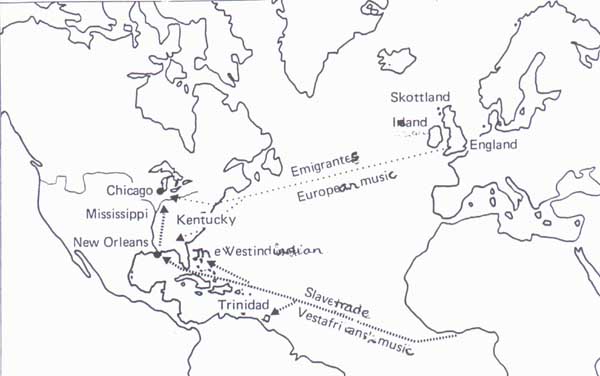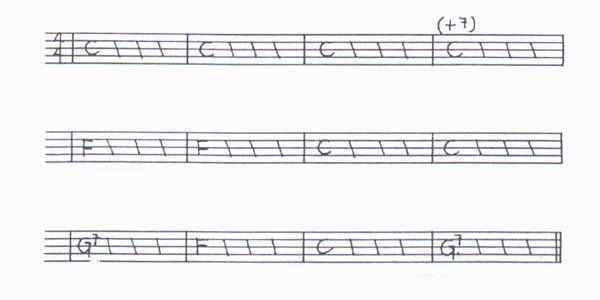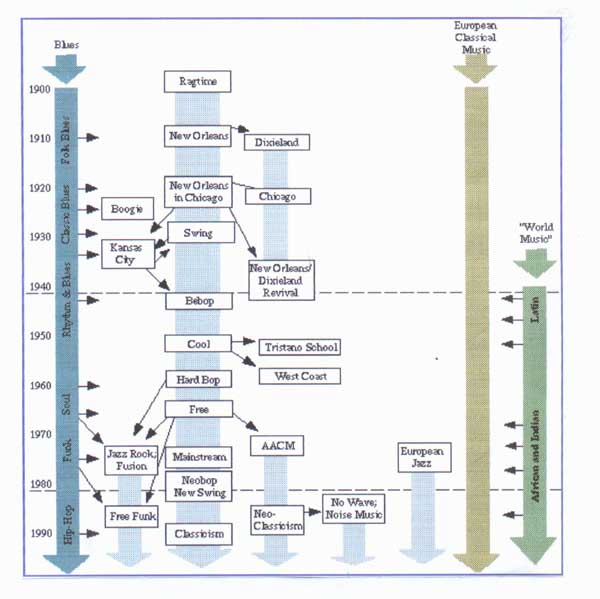Introduction
We have chosen to work on this particular subject, because we wanted to know more about how African musical traditions have influenced our music inheritance. We all know musical genres like blues and jazz, but where did it all come from? We are going to put some music styles in a historical perspective, to better understand how African music still is relevant to our present music culture.
There are several music styles inflicted by African music. Due to the limited time we had to work on this project, we"ve chosen to focus on the most important ones; gospel, blues and jazz.
We've also taken a closer look at these styles' predecessors; Negro Spirituals, work songs and ring-shouts.
Berthold Auerbach, a German writer, once said: "Music is a universal language, with no need for translation."'
It served as a means for communication between the slaves; a way for them to escape the troubles they were facing in the new world. Now their music is spread all around the world, and people of all races are "communicating" by it. And these musical traditions will continue to live on in the lives of future generations, as long as we'll remember.....

The Meeting Between Two Music Traditions
To get a better understanding of the Afro-Americans religious songs and music, its necessary to know about its roots. The history of folk music talks about Afro-American and Afro-European music. These expressions describe a mixture of the two music traditions in the USA. West-African music elements and European music traditions merge into each other on American ground.
The Afro-American music arises and forms the foundation of the music-forms jazz, blues, gospel, soul etc. The music finds its way back to Europe, and the Negroid influence then becomes appreciable ingredients in Western music.

The slaves' music
The period 1600-1850 was a time of stave trading and traffic. This period is like a bloodstain in white man's history. Thousands of West-Africans were stowed on -board cargo ships, and transported to the New World. The slaves were taken to areas in America where there was an urgent need for manpower; the areas with huge plantations.
The U.S. slavery was repealed in 1865. We believe, that during these years, more than ten million people were transported from Africa to America. Families were torn apart, children were separated from their parents. Slave auctions were an everyday phenomenon in the New World.
But slavery didn't manage to break the Africans' will to preserve their culture. They still had their rich music tradition.

West-African Music
Most of the slaves came from these three areas in Africa:
- The West-African savannah - from Guinea to the Senegal coast. This area was strongly influenced by Islam and its culture.
Music : ornamented song, long melody lines, many stringed instruments.
- The rainforest area on the West coast Ghana,, Nigeria and Dahomey.
Music : big striking mechanisms, complicated rhythmics (polyrhythmics).
- The Kongo - Angola - area, The Portuguese and Spanish colonies often got their slaves from here.
Music : mostly polyphonic songs with sung or spoken dialogue.
The West-Africans music is strongly attached to the everyday life, religious ceremonies and dance. The music is an integral part of the tribes' daily life.

The New World
When the Africans arrived, they had to adapt themselves to a new and foreign culture.
They lived under different circumstances, all according to the colony, the work and the time.
Much of the African heritage got lost because, among other things, they were denied the right to practice their religious rituals. The question of whether the ‘black' music would survive or not, all depended on whether the slave was sold to a British (Protestant) or a Latin (Roman Catholic) colony. It seems obvious that the African music had better terms of living in the Latin colonies.
It was usually strictly forbidden to practice these ‘heathen customs' in the Protestant colonies.
A great deal of the West-African music heritage survived, in spite of the suppression
it was carried forward from generation to generation, through attitude and habits, gestures and movements.
The slaves met different ethnic groups in the Southern States, and there is reason to believe that the Blacks gradually picked up features from English and French folk songs, from ballads, Jewish songs and Indian music.
The European folk hymns dominated the religious music in the 1700s and the 1800s.
Because of this meeting between new ethnical groups. the Blacks gradually developed new work songs and religious songs. At the same time they managed to preserve their old culture anti traditions.

Work Songs
The supervisors allowed, and even encouraged, the slaves to sing. The singing contributed them to overcome the monotony in the work out on the field, in a way it raised the work ethic. This was how the concept ‘plantation songs' started. The work song did not only function as a stimulant, where the rhythm of the song subsidized the work-rhythm, but also as a news channel. This was the only way the slaves could talk to each other during work; by singing.
Here, in the songs, the slaves learned about topical occurrences, narratives and the word of God.
The new work songs that came into being among the Blacks in America, were the foundation for the later to be known Afro American music.
The Gospel Music had its fountain in the Work Songs.

Ring-shouts
Another West-African music tradition that survived in the new country, was the Ring-shouts. Through its rhythm and free display, these songs gave valuable impulses to the new American music. The ring-shouts still exists in some parts of the US.
The West-African ring-shouts survived only by a coincidence. The definition of the Protestant prohibition against dance was that you crossed your legs, but, luckily, you didn't do this activity in the dance!
The American music expert Alan Lomax describes the ring-shouts like this:

Spirituals and Calypso
An interesting factor in the meeting between West-African and European music took place on the West Indian islands, especially on Haiti, Cuba, Trinidad and the Bahama-islands.
We find a different form of Negroid religious songs on Jamaica and the Bahama-islands.
This is the so-called "Calypso-Spiritual". These songs remind us of Negro spirituals. The calypso was originally a song-dance from Trinidad.
The text was often sung on "Pidgin -English", and it usually dealt with political and social topics.
Today, Calypso is normally presented by steel bands. The instruments they are using are empty oil drums.
Here you'll find an example of the rhythmical pattern that characterizes Calypso:


Negro Spirituals
Negro Spirituals are, next to jazz, the most familiar form of black music.
"Spirituals" mean spiritual ballads, with motives from the Bible. The songs symbolize the Blacks' religious beliefs.
The songs also became an effectual remedy to make the world aware of the Black's horrible situation. More than 600 Negro Spirituals are known at present time, whereof 260 are published.
The experts of music are not sure of when and where the Negro Spirituals "came to life." Some think that they were created from "'The Empty Space"by some kind of spontaneous ignition in the Black's mind.
They claim, that the music came to life from a latent music inheritance 3 and nothing else.
Others, on the other hand, believe that the songs were created when the African music melted together with the European music in the US.
This theory is developed by M.J. Herskowitz & R.A. Waterman, and it is the most reliable one.
A spiritual can be presented in many different ways. The most original thing about the performance is that you "Blues capture" a melody or give it a slipping tone. This is also one of the phenomena that jazz is known for.
Roughly speaking, we can divide Negro Spirituals into three main groups:
- Responsory song: has a choir-leader and a congregation that answers him or her. For example: "Go down Moses"
- The slow. recitative -melody, as in 'Virgin Mary."
- The syncopated melody, compound of homogenous melodious motives, as in "Rock my soul."
There are two movements in the interpretation of a spiritual; the Afro-American one and the classical European style.
The Afro-American style tries to combine the Spiritual with African music
traditions. Eq. Mahalia Jackson.
The European style has a more "pure" and "true" intonation. Eq. Ellabelle Davis and Roland Hayes.
The texts usually deal with subjects from the Bible, because the slaves needed something to be comforted by when times were tough.
This gave them hope and they found a way to express their sorrow and anger. The eternity-and heaven-motive is often used.
Many spirituals have river motives." Songs like "Deep River", "Down by the River Side" and "I've got peace like a River", all talks about crossing the great river, this is a symbol of death.
The motive of freedom is probably the most prominent trait in Negro spirituals. The ballad of Moses, who led Israel out of Egypt, and Joshua, who fought the battle of Jericho, encouraged the slave's thirst for liberty.

The slaves' language
Very few slaves could read and write when they were pronounced free humans at the end of the civil war.
They spoke with an accent that was a mixture between their own African language, and the words they had picked up from their batman or slave driver. We have the expressions "All God's chillun got shoes", "Everybody talkin' 'baut heav'n. ain't gwain der, ain't gwain der."' (Chillun =children Ain't gwain der=is not going there. From the song "I got shoes".)

Gospel music
The gospel music began in a religious environment, in the Black"s churches around the turn of the century. The gospel music quickly gained enormous popularity, we can find it all over the world in some kind of form or shape, and, its popularity is still growing! Gospel Music as we know it, has its roots in Negro spirituals, jubilee songs, blues and folk hymns.
The term "Gospel" was in use long before the Blacks started practicing it.
The white, Protestant congregations had, already in the 1850's, created songs, that in many ways, reminded people of the popular Camp-meeting Hymns".
These new songs were a mixture between religious folk hymns and the commercial dance-music.
The songs had more "swing" in their melody and rhythm than previous songs.
What separated Gospel from other songs were the following parts:
- text and melody were self-composed
- the songs attached importance to the harmony, rather then the melody line
- they were solely written in major tones.
- they were usect only on instrumental accompaniments
In the Southern States of Kentucky, Virginia, Tennessee and South-Carolina, a song-tradition developed, that later became the foundation of a new religious music style; Country-Gospel. The rural districts here were small and isolated, so the musical traditions from England, Scotland and Ulster remained well preserved.
The songs were called "Mountaineer Ballads" or "Hillbilly Songs".
(Hillbilly = a disparaging description of a mountaineer).
The instrumental music was called "Bluegrass" and it is almost the same as our "'Spillemannsmusikk" (Norwegian). Mandolin, banjo, fiddle and bass became standard instruments within the Bluegrass-music. These styles also occur in the music style Country&Western.
Important names in this genre are: The Carter Family, Jimmie Rodgers Oak Ridge Boys and The Blackwood Brothers Quartet.
"Church of God in Christ" was the first black religious community to sing gospel.
They became famous around 1900, because of their bubbling, cheerful and often shouting songs. The songs were accompanied by guitars, trumpets and drums.
Some important names are Thomas A. Dorsey, who made gospel famous through his music in the 1920's. He was the founder of the new music style Country-Blues-Gospel.
You also have Blind Lemon Jefferson, who started out as a busker, and the blind woman Arizona Drane, Mahalia Jackson's biggest idol.
The name itself - Gospel - tells us that the songs have its foundation in the Bible. In Norwegian the word Gospel means cc evangelism, forkynnelse".
It s. quite logical that we find motives from the Bible in most of the songs. They usually describe a scriptural person, eq. "Jonah in the Belly of the Whale"'.
Sometimes central theological subjects are discussed, like God's omnipotence andjesus' suffering and death.
many gospel-songs are created spontaneously during a service. You simply feel "the spirit" and start to improvise.
- You move your whole body, hands, feet, stomach and hips.
- The worship of God occurs mainly through singing and dancing.
- Those who are dancing, always move in a circle towards the sun.
- The melody has a choir-leader. He or she repeats the refrain. This fortifies the team.
- The song's intensity factor increases and mass hypnosis breaks out.
Main sources of influence:


The Blues
" We were always singing in the fields. Not real singing,
you know just hollerin', but we made up our songs about
things that were happening to us at the time and / think
that's where the blues started.
- Son House
The blues is the most independent type of black music in the African -American tradition. The musical style wasn't really developed before after slavery had been embellished in 1865, but the blues is deeply rooted in the slaves' work songs, gospel and Negro spirituals. Some say that the blues was born in the cotton fields of the Mississippi Delta where cotton choppers and pickers sang to make the work go easier. These songs were influenced by African tribal songs, work chants and "hollers". But even after the slaves were given back their freedom, they were not considered as equals by the rest of the population. Most of them were poor and their living accommodations were bad, they were illiterate and despised. It was under these circumstances the term "being blue" appeared. The colour blue expressed a feeling of sadness and depression, and of being lonely. While Negro spirituals lent itself to a choral treatment and expressed the blacks' need for spiritual guidance, the blues was about people and their everyday struggles. Blues lyrics was about money problems, broken hearts, loneliness and sickness. Melancholy, however is most frequently the theme; the essence of the blues is in such traditional lines as "Got the blues, but too damn mean to cry". Sometimes the lyrics even criticized social and political injustice. The composer Arnold Shaw describes the blues in his book "The World of soul" this way: "Even though the blues describes people without a home, without love, money, status and identity, these people were not without hope. There was melancholy, but not without merriment; frustration, but not without expectations; despair, but not without determination; suffering, but not without endurance."
In its simplest form, the blues consists of the three cords that is the basic of our "musical language". These cords are called
Tonika (T), Subdominant (S) and Dominant (D) in every key. We find them on the first, fourth and fifth step in the scale.

The figure underneath shows an example of a common harmony structure in a I 2-bar blues.

A blues song has a basic rhythm and a melody rhythm. The basic rhythm remains the same throughout the song and carries the melody line. The melody line is improvised. A blues song is foremost played on a guitar, but also on harmonica and banjo.
It would be impossible to write about blues without mentioning a man named W.C. Handy (1873-1958). He is often referred to as "Father of the Blues". He was a musician and a composer himself and he started gathering old blues songs and writing them down, something that hadn't been done before. He wrote over 60 blues tunes, and also rewrote some melodies that were circulating. Among the most known Handy songs, we find "Memphis Blues", "Blues Destiny" and "St. Louis Blues". The sheet music to "St. Louis Blues" have been sold in over 3 million copies.
There are also connections between blues and jazz. Boogie-woogie is a particular style of piano playing in early jazz. It is constructed on a 12-bar blues scale. Socially it has its origin in Florida and Missouri. Many believe it musically speaking to have been developed from early piano jazz from St. Louis or Kansas City. In 1900 it was known as "honkey-tonk" in New Orleans. Boogie-woogie is characterized by right-hand melody improvisation and lefthand repeated rhythmic motive, a sort of "walking bass".
There is also a blues style called Rhythm and Blues, or just the abbreviation R&B. It is often referred to as "Mainstream Blues", and has influenced musical styles like rock'n'roll and soul. In fact soul and R&B are very similar to each other.
There have been many famous blues artists. Maybe the most legendary being Robert Johnson (191 2-ca. 1938).
The legend states that he went down to a crossroad and struck a deal with the devil, which made him able to play the guitar like no mortal could do. He recorded some immortal blues classics in 1936 and 1937, like "Cross Road Blues" and "Sweet home Chicago". He has been the inspiration of numerous guitar players, not only in the blues genre. There has been many other great blues artists, like Muddy Waters, B.B. King, T-bone Walker, Screaming Jay Hawkins, Howling Wolfe and, last but not least, Leadbelly.


Jazz
No matter what type of music you listen to now, it"s almost certain that it was influenced by the jazz music that became popular earlier in the twentieth century. People of all races enjoy listening to and playing jazz. However, the influence black Americans had on jazz as a form of music and as an important part of American culture (particularly African-American culture) started earlier in this century.
Although jazz definitions vary depending on whom you ask, there are certain elements, which will always be presented. Especially improvisation and syncopation, the latter sometimes referred to as "swing". Today improvisation usually means "solos", musicians taking turns expressing their musical interpretation of a given song.
Early jazz began in the Black community of New Orleans, composed by the African-American and Afro-French (Creole) population. Jazz developed from folk sources. Its origins are shrouded in obscurity, but the slaves torn from their own ancestral culture, developed it as a new form of communication.
After the slaves were freed, Afro-American music grew rapidly. The availability of musical instruments, including military band discards, and the new-found mobility gave birth to the basic roots of jazz: brass and dance band music and the blues.
Ragtime, especially in its watered-down popular versions. was entertainment designed for the middle class and was frowned on by the musical establishment. The music not yet called jazz, came into being during the last decade of the 19th century, rising out of the black working-class districts of southern cities. Like ragtime, it was music meant for dancing.
Most veteran jazz musicians state that their music had no specific name at first, other than ragtime or syncopated sounds. The first band to use the term jazz was that of trombonist Tom Brown. a white New Orleanian who introduced it in Chicago in 1915. The band that made the word stick was also white and also from New Orleans. the Original Dixieland jazz Band. This group had a huge success in New York in 1917-18 and was the first more or less authentic jazz band to make records.
The city that has become synonymous with early jazz is New Orleans. There is reality as well as myth behind this notion. New Orleans played a key role in the birth and growth of jazz, and the music's early history has been more thoroughly researched and documented there than anywhere else. What was unique to New Orleans at the time was a very open and free social atmosphere. People of different ethnic and racial background could establish contact, and out of this easy communication came a rich musical tradition involving French, Spanish, German, Irish and African elements. It was no wonder that this cosmopolitan and lively city was a fertile breeding ground for jazz.
But, while the city may have had more and better jazz than any other from about 1895 to 1917, New Orleans was by no means the only place where the sounds were incubating. Every southern city with a sizeable black population had music that must be considered early jazz. By 1917, many key jazz players, white and black, had left New Orleans and other southern cities to come north. The reason was not the notorious 1917 closing of the New Orleans red light districts, but simply economics. The 1. World War in Europe had created an industrial boom. and the musicians merely followed in the wake of millions of workers moving north, because they were promised better jobs.
By the early years of the second decade, the instrumentation of the typical jazz band had become cornet (or trumpet), tribune, clarinet, guitar, string bass and drums. (Piano rarely made it since most jobs were on location and pianos were hard to transport). The banjo and tuba, so closely identified now with early jazz, actually came in a few years later because early recording techniques couldn't pick up the softer guitar and string bass sound. The cornet played the lead, the trombone filled put the bass harmony part in a sliding style, and the clarinet embellished between these two brass poles. The first real jazz improvisers were the clarinettists, among them Sidney Bechet (1897-1959). An accomplished musician before he was 10, Bechet moved from clarinet to laying mainly soprano saxophone. He was to become one of the most famous early jazzmen abroad, visiting England and France in 1919 and Moscow in 1927.
�Louis Armstrong dominated the musical landscape of the 20's and-, in fact, shaped the jazz language of the decade to come as well. But the jazz of the Jazz Age was more often than not just peppy dance music made by young men playing their banjos and saxophones and who had little understanding of (or interest in) what Louis Armstrong was about. Still a surprising amount of music produced by this dance-happy period contained genuine jazz elements.

Conclusion
We can assure you that the information we have managed to compile in this project, is only the peak of an iceberg.
But, as mentioned before, we had a limited time available. There are many other genres we could have written about, like rockn'roll, soul, rap, reggae and pop. Well, maybe some other project?
The slaves came to the new world with nothing except their traditions and their music. I guess that's why they held on to it and kept it alive through their difficulties. It helped them and made them stronger. The traditions faded somehow, but the music merged with European genres and continued to live on.
We think we find the strongest Afro-American influences within music.
No matter if you are a slave or a free man, music is for everybody.
As Plato once said: "Music gives the universe soul, the mind wings and the imagination a chance to escape. It gives seriousness charm and happiness and joy to all life."

Sources:
- "Blues - An Anthology" by W.C. Handy
- Two jazz web pages, their adresses are:
www.jazzcentralstation.com/jcs/station/newsstan/history/204thist.html
www.wnur.org
- "Gospel" by Elliot Jackson
- Bruce Boyd Readburn, ph.d
- "Jazz" by George Brown
|



